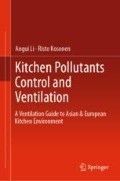Abstract
This chapter introduces the theoretical and experimental study for thermal plumes of kitchen appliances, as well as the methods to determine airflow rates for kitchen exhaust hoods. Convection plumes from an iron range, a chrome range, a gas range, and an induction griddle are analyzed under idling and cooking conditions. Exhaust airflow rate requirements to capture, contain, and remove effluent vary considerably depending on hood style, presence and size of side panels, cooking equipment, food, and cooking processes involved. The calculation methods of exhaust airflow rate are proposed such as face velocity methods, energy balance method, and convection load method.
Access this chapter
Tax calculation will be finalised at checkout
Purchases are for personal use only
References
Batchelor GK (1954) Heat convection and buoyancy effects in fluids. Q J R Meteorol Soc 80 Pages, 339–358
AS 1668.2-2002 (2002) The building code of Australia Part F4—Light and ventilation Australian Standard
ASHRAE Handbook (2015) ASHRAE handbook—HVAC applications. American Society of Heating, Refrigerating, and Air-Conditioning Engineers Inc., Atlanta
ASTM F1704-2012 (2012) Standard test method for capture and containment performance of commercial kitchen exhaust ventilation systems. United States
ASTM F1704-1999 (1999) Standard test methods for performance of commercial kitchen ventilation systems. United States
Auban O, Lemoine F, Vallette P, Fontaine JR (2001) Simulation by solution by solutal convection of a thermal plume in a confined stratified environment: application to displacement ventilation. Int J Heat Mass Transf 44(24):4679–4691
Baturin VV (1972) Fundamentals of industrial ventilation. Pergamon Press
Bouzinaoui A, Vallette P, Lemoine F, Fontaine JR, Devienne R (2005) Experimental study of thermal stratification in ventilated confined spaces. Int J Heat Mass Transf 48(19):4121–4131
CP 13 (2000) Singaporean code of practice for mechanical ventilation and air-conditioning in buildings. Productivity and Standard Board. Singapore
Dai Z, Tseng LK, Faeth GM (1994) Structure of round, fully developed buoyant turbulent plumes. J Heat Transf 116(2):409–417
Fitzner K (1991) Quell-Luftung, Forschungsbericht Nr 522, Klimatechnisches Laboratorium Betzdorf, Heinrich Nickel GMBH Klima-und Lufttechnik
George WK, Albert RL, Tamini F (1977) Turbulence measurements in an axisymmetric plume. Int J Heat Mass Transf 20(11):1145–1154
Gerstler W, Kuehn T, Pui D, Ramsey J, Rosen M, Carlson R, Petersen S (1999) Identification and characterization of effluents from various cooking appliances and processes as related to optimum design of kitchen ventilation systems. Final report, ASHRAE
Jiang DH (2018) Characteristics of cooking thermal plume diffusion in the kitchen. Xi’an University of Architecture and Technology
Jin YH (1993) Particle transport in turbulent buoyant plumes rising in a stably stratified environment. Ph.D. thesis, Staub-Reinhaltung der Luft 53(9):343–350
Kofoed P (1991) Thermal plumes in ventilated rooms. Ph.D. thesis, Department of Building Technology and Structural Engineering, Aalborg University, Denmark
Kofoed P, Nielsen PV (1975) Thermal plumes in ventilated rooms-Measurements in stratified surroundings and analysis by use of an extrapolation method. In: RoomVent-90, international conference, Oslo, Norway
Kosonen R (2001) Energy efficient design method in commercial kitchens. In: ASHRAE Asia Pacific conference on the built environment, November 2001, Singapore
Kosonen R, Koskela H Saarinen P (2006a) Thermal plumes of kitchen appliances: Part 1 Idle mode. Energy Build 38(9):1130–1139
Kosonen R, Koskela H, Saarinen P (2006b) Thermal plumes of kitchen appliances: Part 2 Cooking mode. Energy Build 38(10)1141–1148
Kosonen R, Koskela H, Saarinen P (2006c) An analysis of thermal plumes of kitchen appliance. In: Proceedings of 17th of air-conditioning and ventilation conference, Prague Czech Republic, 17–19 May 2006
Melikov AK, Sawachi T (1992) Low velocity measurements: comparative study of different anemometers. In: Proceedings of RoomVent-92. International conference, Aalborg, Denmark
Mierzwinski S (1992) Testing and modelling of thermal plumes in rooms. In: Proceedings of ISRACVE, University of Tokyo
Morton BR, Taylor G, Turner JS (1956) Turbulent gravitational convection from maintained and instantaneous sources. Proc R Soc Lond 234(1196):1–23
Mundt E (1996) The performance of displacement ventilation systems- experimental and theoretical studies. Ph.D. thesis, Bulleting nr 38, Building Service Engineering, KTH, Sweden
Nakagome H, Hirata M (1976) The structure of turbulent diffusion in an axisymmetric thermal plume. ICHMT. vols 1–2, Dubrovnik
Nielsen PV (1993) Displacement ventilation—theory and design. Aalborg University. ISSN 0902-8002 U09306
Papanicolaou PN, List EJ (1988) Investigations of round vertical turbulent buoyant jets. J Fluid Mech 195(195):341–391
Popiolek Z (1981) Problems of testing and mathematical modelling of plumes above human body and other extensive heat sources. A4-series no. 54, Department of Heating and Ventilating, Royal Institute of Technology, Stockholm, Sweden
Popiolek Z, Mierzwinski S (1984) Buoyant plume calculation by means the integral method. KTH Stockholm A4- serien no 89, Department of Heating and Ventilation, Royal Institute of Technology, Stockholm, Sweden
Rouse H, Yih CS, Humbrey HW (1952) Gravitational convection from a boundary source. Tellus 4(3):201–210
Schmidt W (1941) Turbulente Ausbreitung eines Stromes Erhitzter Luft. J Appl Math Mech 21(5):265–278
Shepielev IA (1978) Aerodinamika vozdusnych potokov v pomiescenii. Strojizdat, Moskov Russia
Skåret E (1986) Ventilasjonsteknikk, Inst. of heating, ventilation and saniratary techniques. NTH, Trondheim Textbook (Norwegian)
Turner JS (1972) Buoyancy effect in fluids. Cambridge University Press, Cambridge
UL 710-2012 (2012) Exhaust hoods for commercial cooking equipment, 6th edn. Underwriters Laboratories, Northbrook, IL
Verein Deutcher Ingenieure VDI (1984) Standard 2052: Ventilation equipment for kitchens
Verein Deutcher Ingenieure VDI (2006) Standard 2052: Ventilation equipment for kitchens
Welling I (1993) An investigation of the SVD-method for analyzing convection plumes. Ph.D. dissertation, University of Helsinki, Department of Physics. Helsinki Finland
Zhao YJ (2013) Study on pollutant control principle and performance of local exhaust hood. Ph.D. dissertation, Xi’an University of Architecture and technology (in Chinese)
Author information
Authors and Affiliations
Corresponding author
Rights and permissions
Copyright information
© 2019 Springer Nature Singapore Pte Ltd.
About this chapter
Cite this chapter
Li, A., Kosonen, R. (2019). Basis to Calculate Exhaust Airflow Rate. In: Kitchen Pollutants Control and Ventilation. Springer, Singapore. https://doi.org/10.1007/978-981-13-6496-9_5
Download citation
DOI: https://doi.org/10.1007/978-981-13-6496-9_5
Published:
Publisher Name: Springer, Singapore
Print ISBN: 978-981-13-6495-2
Online ISBN: 978-981-13-6496-9
eBook Packages: EngineeringEngineering (R0)

